Past OCCRA Games
2000 Something |
2001 Something |
2002 |
2003 |
2004 |
2005 |
2006 |
2007 |
2008 |
2009 |
2010 |
2011 |
2012 |
2013 |
2014 |
2015 |
2016 |
2017 |
Game Rules: 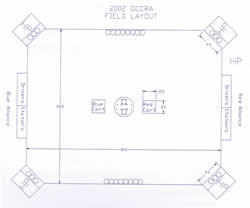
Two alliances will play at a time on the court, and there will be two teams in each alliance during the seeding matches. For each team in the alliance, two student drivers, a human player, and a student coach are the only ones allowed on the playing field or in the staging area. The game pieces are yellow 10" diameter rubber balls. Each ball has a multiplier value of one. Ther are 30 of these balls in play during each match.
The object of the game is to build a robot that can pick up the balls and place them in the position that gains your team a scoring advantage by the end of the match. Each alliance is assigned a color and has a mobile scoring cart and a scoring goal-tower of that assigned color (either read or blue). The match score for an alliance will be calculated by multiplying the number of ballsin their scoring cart. The scoring goal has two colored towers where each alliance can score balls: a short tower that is 24" off the floor and a tall tower that is 72" above the floor level. Balls may also be placed inside the goal towers by forcing them in between the vertical PVC pipes. The scoring goal for an alliance is identified by a color that is randomly assigned for each match (either read or blue). Placing a ball inside your opponent's colored goal structure does not earn points unless you also place at least one ball inside your opponent's scoring cart.
Each match will last two minutes. The score for each match is determined by the position of the balls and robots at the end of the match. The alliance with the highest amount of points is the winner. The winner of the match will receive 10 bonues points plus their ball score. The losing team will receive only their ball score.
Robot interaction is allowed and expected anywhere on the field. This includes pushing, shoving, bumping, blocking and fighting for position. However, robot action/contact intended to disable or damage the opponent is forbidden. Pinning a robot for more than five seconds and preventing them from moving is not allowed. Entangling or latching on to an opponent is not allowed as it is considered to be a form of pinning. Blocking a robot's path is allowed because this allows for the interaction that happens as it occurs. Robots may push an opponent's cart but may not latch on or pull an opponent's cart.
Game Rules:
Two alliances will play at a time on the court and there will be two teams in each alliance during the seeding matches. For each team in the alliance, two student drivers, a human player, and a student coach are the only ones allowed on the playing field or in the 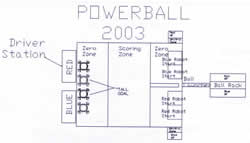 staging area.
staging area.
The game pieces are yellow 13" diamter rubber balls and a single green 24" ball. Each yellow ball has a base value of one point (1) when in scoring position. There are twenty-four (24) of hese yellow 13" balles in play during each match. The base value of the green "Power Ball" is five (5) points.
The object of the game is to build a robot that can pick up the balls and place them in the position that gains your team a scoring advantage by the end of the match. Balls that are held off the ground by a robot within the scoring zone each score their base value (either 1 or 5 points). Balls that are placed into a goal that is in the scoring zone will have their value doubles (either 2 or 10 points). Each alliance is assigned a color and has two scoring goals of that assigned color (either blue or red.) The match score for an alliance will be calculated by doubling the value of the balls in their scoring goals and adding this score to the value of the balls held by the alliance robots in scoring position. The scoring goals have different sized towers; each alliance has a short tower that is 36" off the floor and a tall tower that is 72" above the floor level. All goal towers have openings at the top that the balls will fit into. The scoring goals for each alliance are identified by a color that is randomly assigned for each match (either blue or red).
Each match will last two minutes. The score for each match is determined by the position of the balls at the end of the match. Thescores are then tabulated and a winner is determined. The alliance with the highest amount of points is the winner. The winners of the match will each receive 10 bonus points plus their ball score. The losing teams will receive only their ball score.
Robot interaction is allowed and expected anywhere on the field. However, robot action/contact intended to disable or damage the opponent is forbidden. Pinning a robot for more than five (5) seconds and preventing them from moving is not allowed. Robots may push an opponent's goalbut may not latch on or pull an opponent's goal. A robot may not attempt to block an opponent from placing balls in scoring position by covering the opening at the top of the goal ("goaltending").
Game Rules
Two alliances will play at a time on the court (red and blue) and there will be two teams in each alliance during the seeding matches. For each team in the alliance, two student drivers, a human player, and a student coach are the only ones allowed on the playing field or in the staging area.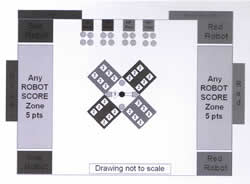
The game pieces are assemblies of three 3" diameter PVC pipes (a.k.a. "tubies") that are 7" long. There are 20 of these tubies in play during each match. The scoring structure has four colored ramps that connect to a central platform. The scoring ramps for each alliance are identified by the color that is randomly assigned for each match (either red or blue). Tubies score points when placed into the holes on the ramps and when placed up on the rotating arrow on the central platform. Each robo that gets into the end zone at the end of the match also scores points.
The object of the game is to build a robot that can pick up the tubies and place them in scoring positions by the end of the match. Each alliance is assigned a color and has two ramps of that assigned color (either red or blue). The human players will be on the field for the first 15 seconds of the match and may not place tubies on other teams' robots or on the field structures. They may not place more than 2 tubies on their own robot.
The match score for an alliance will be calculated by adding: The number of points from the tubies on the ramp (2-points each) 5 points for the alliance that the arrow is pointing toward at the end of the match, 5 points for each tubie on the arrow (for the alliance that the arrow is pointing at), and 5 points for each robot that is in the end zone at the end of the match.
Each match will last two minutes. The score for each match is determined by the position of the tubies and robots at the end of the match. The alliance with the highest amount of points is the winner. The winners of the match will each receive 10 bonus points plus their match score. The losing teams will receive only their match score.
Game Rules
Teams play a set number of matches in which they are randomly paired with an alliance partner. Two alliances (the red and the blue) play at a time on the court and there are two teams in each alliance. If a team is unable to compete, the remaining team in the alliance plays alone for that match or with the help of a league-supplied substitute robot (a.k.a. the "placebo".) The winners of the match will each receive 10 bonus points plus theri ball score. The losing teams will receive only their ball score. The alliances change with each seeding match and the team with the most points at the end of the matches wins the tournament.
The object of the game is to score more points than your opponents. Scores are tallied 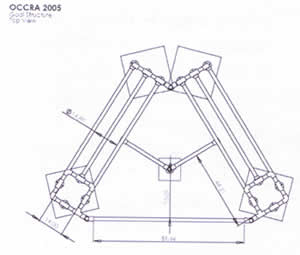 at the end of each 2-minute match. Each alliance has 3 different scoring goals of their color: a lower rack, an upper rack, and a scoring tower. Any of the 24 yellow balls that are placed in the towers or scoring racks score 1 point each while the 5 red "ricochet" balls score 3 points apiece. (In the first few seconds of the match you will see how the red balls got the name "ricochet"!) An opponent may not remove balls scored in the towers but balls placed on one of the racks may be removed before the end of the match. A ball that is placed into a scoring rack during a match but removed before the end of the match does not count as a score. An additional bonus of 5 points is awared for each robot that is hanging from the hanging bar at the end of the match.
at the end of each 2-minute match. Each alliance has 3 different scoring goals of their color: a lower rack, an upper rack, and a scoring tower. Any of the 24 yellow balls that are placed in the towers or scoring racks score 1 point each while the 5 red "ricochet" balls score 3 points apiece. (In the first few seconds of the match you will see how the red balls got the name "ricochet"!) An opponent may not remove balls scored in the towers but balls placed on one of the racks may be removed before the end of the match. A ball that is placed into a scoring rack during a match but removed before the end of the match does not count as a score. An additional bonus of 5 points is awared for each robot that is hanging from the hanging bar at the end of the match.
Each alliance has two human players who may throw balls into the scoring tower or the scoring racks, or feed the balls to a robot. One of these human players is designated the "feeder" and the other player is the "shooter." Human players must stay entirely within their own designated zones during the entire match. If a human player steps out of their zone while a ball is in their possession, the ball will be taken and returned to the field of play. Human players may only have one ball in their possession at a time and they may not place balls on the floor.
Game Rules
The OCCRA 2006 game is called "TEETER-TOTTER TROUBLE." Teams play a set number of matches in which they are randomly paired with an alliance partner. Two alliances (the red and the blue) play at a time on the court and ther are two teams in each alliance. If a team is unable to compete, the remaining team in the alliance plays alone for that match or with the help of a league-supplied substitue robot (a.k.a. the "placebo.") The winners of the match will each recieve 10 bonus points plus their ball score. The losing teams will recieve only their ball score. The alliances change with each seeding match and the team with the most points at the end of the matches wins the tournament.

The object of the game is to score more points than your opponents. Scores are talliled at the end of each 2-minute mathch. Each alliance has 2 different scoring goals of their color: a mobile goal that must be in the "scoring zone" at the end of the match, and a scoring goal on one half of the teeter-totter. If any of the 32 balls, regarless of size and color, are in one of the goals at the end of a match, it will score 1 point for the alliance of that color. An opponent may remove balls from the goals before the end of the match. A ball that is placed into a goal during a match but removed before the end of the match does not count as a score. A 3-point bonus is awared for each robot that is completely on the ramp or platform at the end of the match. An additional bonus of 5 points is awarded to the alliance that has the teeter-totter tipped their way at the end of the match.
Each alliance has two human players who may launch balls into the mobile goals, onto the field, or into their robot. One of these human players is designated the "Feeder" and the other player is the "Launcher". Human players must stay entirely within their own designated zones during the entire match. If a human player steps out of their zone while a ball is in their possession, the ball will be taken and returned to the field of play. Human players may not intentionally throw or launch balls at spectators or the opponents' human players, drivers, coaches, or robots.
Game Rules
The OCCRA 2007 game is called "LET'S ROCK!" Teams play a set number of matches in which they are randomly paired with an alliance partner. Two alliances (the red and 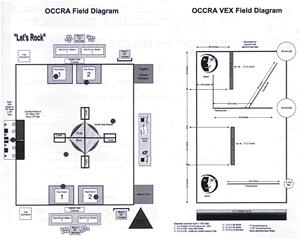 the blue) play at a time on the court and there are two teams in each alliance. If a team is unable to compete, the remaining team in the alliance plays alone for that match or with the help of a league-supplied substitue robot (a.k.a. the "placebo"). The winners of the match will each recieve 10 bonus point plus their ball score. The alliances change with each seeding match and the team with the most points at the end of the matches wins the tournament.
the blue) play at a time on the court and there are two teams in each alliance. If a team is unable to compete, the remaining team in the alliance plays alone for that match or with the help of a league-supplied substitue robot (a.k.a. the "placebo"). The winners of the match will each recieve 10 bonus point plus their ball score. The alliances change with each seeding match and the team with the most points at the end of the matches wins the tournament.
The object of the game is to score more points than your opponents. Scores are tallied at the end of each 2 minute 15 second match. Each alliance has 3 different kinds of scoring goals of their color: a low rack or "trough", a set of 4 rocking "cradles", and a central scoring structure. Any of the 24 small balls that are placed in the troughs or central scoring structure score 1 point each while the 9 large balls score 3 points apiece. An opponent may not remove balls scored in the central scoring structure but balls placed in one of the troughs or cradles may be removed before the end of the match. A ball that is placed into a scoring rack during a match but removed before the end of the match does not count as a score.
The first 15 seconds of each match is the time when the totally autonomous 18" VEX robots attempt to put the 5 pedestal balls into their scoring troughs. Officials will remove any of the 5 pedestal balls that do not get scored by the end of the autonomous period. The next 2 minutes of the match are played exclusively by the full-size robots.
Each allance has two "human players": the "Shooter" may throw balls into the goals and the "Feeder" may feed the balls to a robot. The human players must stay entirely within their own designated zones during the entire match. If a human player steps out of their zone while a ball is in their possession, the ball will be taken and returned to the field of play. Human players may not intentionally throw balls at spectators or the opponents' human players, drivers, coaches, or robots. Human players may pass balls to each other.
Robot interaction is allowed and expected anywhere on the field. This includes pushing, shoving, bumping, blocking, and fighting for position. However, robot action/contact intended to disable or damage the opponent is forbidden. Pinning a robot for more than five (5) seconds and preventing them from moving is not allowed. A robot may not intentionally flip an opponent's robot over or block an opponent from placing balls in scoring position by covering the opening at the top of the scoring goals ("goaltending"). A robot may attempt to steal or push a ball from an opponent at any time. Which contact is allowable is left to the referee's discretion. Referees may issue warnings of rule infractions to teams; if issued a warning, the teams are expected to stop the infraction or face possible power loss and/or disqualification. A yellow flag thrown by a referee indicates that an official warning orange flag will be thrown to indicate that a team has been disqualified.
Game Rules:
The 2008 OCCRA game is called "Football Frenzy". OCCRA robots will be kicking, passing and catching footballs in this year's head-to-head competition. The competition structure randomly pairs robots from two different schools in an "alliance" against two robots from an opposing alliance. The large robots may weigh as much as 120 pounds and be as much as 40 inches tall at the start of the match. The little VEX robots may be as tall as 18 inches at the start of the match with no weight limit.
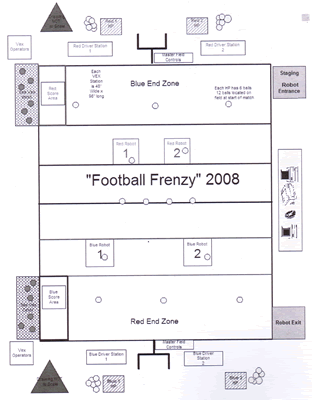
Matches start with a 15-second "autonomous" period during which time the VEX robots are run by a computer program loaded earlier. During the first 15 seconds, only the VEX robots will move. During the autono ous time, the VEX robots score 6 points for each field goal that they make. After the autonomous period, bot the VEX robots and the larger robots have two minutes to score points under the radio-control of student drivers. Teams may each have five students on the fiedl during the matches: 2 drivers for their big robot, one driver for the VEX robot, one "Human Player", and one coach.
Scoring for the VEX and the large robots score one point for each ball that they have in their lower goal at the end of the match. The large robots score 3 points for each field goal that they make during the match, and they score 7 points for each touchdown. Touchdowns can only be scored with the brightly colored orange and purple footballs that are put into play during the last 30 seconds of the match. The teams on the winning alliance each get ten additional points per match. At the end of the tournament, the team with the most points is the winner.
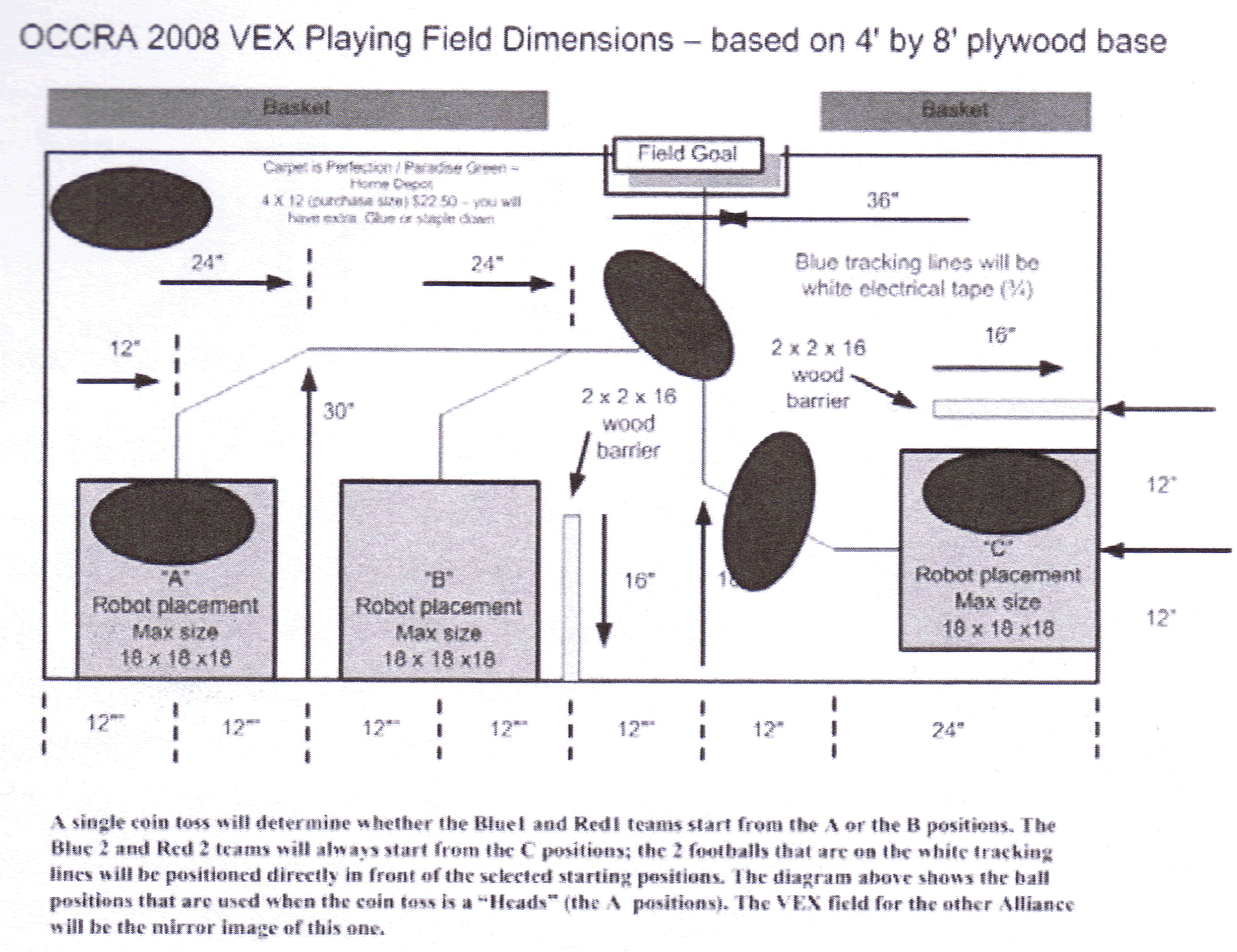
Robots are not allowed to shoot field goals from beyond the midfield line. Human Players are allowed to pass footballs to each other, but not allowed to pass footballs over the midfield line. Robots are allowed to push and shove their opponents. OCCRA robots play rough and some damage will surely occur; but the rules prohibit teams from intentionally damaging another maching. A "Placebo" robot is available for use if a large robot is not able to compete in its match.
The 2009 Oakland County Competitive Robotics Association (OCCRA) game is called "'Bot Basketball." OCCRA robots will be passing, shooting and slam-dunking basketballs in a head-to-head competition. The competition structure randomly pairs robots from two different schools in an "alliance" against two robots from an opposing alliance. The large robots may weigh as much as 120 pounds and measure as high as 40 inches tall at the start of the match. The little VEX robots may be as tall as 22 inches at the start of the match with no wieght limit.
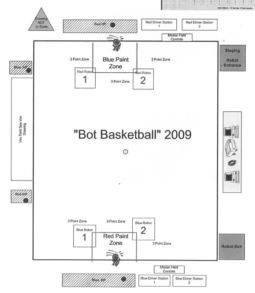
Matches start with a 15-second "autonomous" perioud during which time the VEX robots are run by a computer program loaded earlier. During the first 15 seconds, only the VEX robots will move. Diring the autonomous time, the VEX robots score 3 points for each brown basketball that they put through the basket. After the autonoous period, the VEX robots have another 15 seconds of radio-controlled time to score baskets that count for 1 point each. Once the large robots start, the VEX robots can continue to feed balls into the troughs at the side of the field but no more points are awarded. The larger robots have two minutes to score pointes under the radio-control of student drivers.
Each brown basketball that is scored while the robot is in the "Paint" counts for one point. Each basket that is scored from outside of the 8' by 8' painted zone counts as 3 points. There are two bonus balls in play that triple the value of any shot that is made. Robots are not allowed to possess more than one ball at a time.
Teams may each have five students on the field during the matches: 2 drivers for their big robot, one driver for their VEX robot, one "Human Player", and one coach. The teams on the winning alliance each get ten additional points per match. At the end of the tournament, the team with the most points is the winner. The matches will be scored in real-time. Adjustments may be made after the match at the referees' discretion (penalties, mistakes, etc.)
Robots are not allowed to "goal-tend" or stay more than three seconds in the "Paint" while on defense. Human Players are allowed to pass basketballs to each other and their alliance robots but may not take shots. Robots are allowed to push and shove their opponents. OCCRA robots play rough and some damage will surely occur but the rules prohibit teams from intentionally damaging another machine. A "Placebo" robot is available for use if a large robot is not able to compete in its match.
The object of the game is to use both the large (40" tall) robots and the little (18" tall) VEX robots to score the most points by placing 10" playground balls onto the opponents' field and/or to hang one's own robot off of the field. Scoring occurs at the end of the match. A 5 foot high wall separates the playing field into a RED ZONE and a BLUE ZONE. A one-foot high platform is centered along the wall forming a passageway between the two zones. Two four-foot long steel bars are mounted horizontally above this passageway at a height of six feet above the floor. At the end of the match, all large robots that are hanging from one of the hanging poles will score seven points for their alliance. VEX robots that hang score 3 points for their alliance.
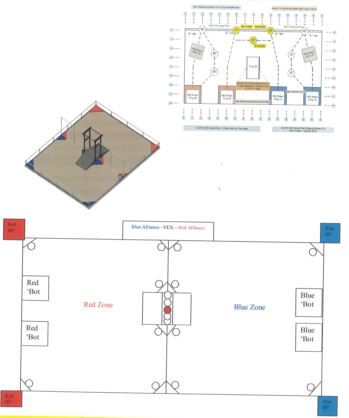
There are three operating periods for each match. First, there is a 20-second VEX-only autonomous (no human control) period. The next operating period is for both the large robots and the VEX robots. During this 90-second time period, the large robots and the VEX robots are controlled by the handler/driver via radio signals. VEX robots may move balls from the VEX field onto the large field during this period and may also hang from the hanging bar to score 3 additional points for their team. The large robots try to move balls to their opponents' side of the field during this radio-controlled time period. The final 30 seconds is also a radio-controlled period but only for the large robots. The large robots may continue putting balls into their opponents' zone or may attempt to hang.
The "Up and Over" game pieces are 10" rubber balls. There are 26 "regular" red balls and four yellow "bonus" balls. The scoring of any ball depends upon where it is located at the end of the match. Regular balls (red) score one point each and yellow bonus balls count for three points each. Each ball that is in a colored zone at the end of the game will score points for the alliance of the opposing color. Each team has a "human player" (HP) who may load balls into robots or introduce them on to the field by throwing. Balls that are with a HP or onboard a robot will count against that alliance at the end of the match. Robots must not hold more than five balls at a time during a game.
A robot may enter the zone of the opposing alliance during the match but must leave the opponents' zone before the end of the match or it will be a ZONE VIOLATION with a 5-point penalty. Robot interaction is allowed and includes pushing, shoving, bumping, blocking, setting "picks" and fighting for position. However, robot action/contact intended to disable or damage the opponent is forbidden.
A "Clean Sweep" is declared when all of the balls are on one side of the field. In seeding matches, the alliance with the highest amount of points is the winner. The winners of each seeding match receive 10 bonus points plus their match score.
The object of the game is to use both the "large" robots and the little "VEX" robots to score the most points by placing rubber balls of the correct color into the nine goals on the playing field. One two-team alliance is called the "BLUE Allance" and their opponents are teh "RED Alliance." Scoring occurs at the end of the autonomous period on the VEX field and the end of the match on the large field. Each ball placed into a goal scores one point for the alliance with that color. The top ball in each goal determines which alliance, RED or BLUE, "owns" the goal. At the end of the match, rows that are completely owned by one of the alliances score 3 bonus points for that alliance. The combination of these two scores, munus any penalties, determines the alliances' match scores. The winning alliance earns a 10-point bonus for the standings. For the regional tournaments, the team with the highest point total at the end of the day wins the tournament.
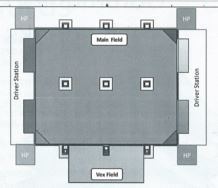
There are two operating periods for each match: a 20-second VEX-only autonomous period and a two-minute radio-controlled period for both the large robots and the VEX robots. VEX robots can score during the AUTON period by putting balls into goals and by moving the balls from the VEX field onto the large field. The first VEX robot to knock a ball off of a pedestal during the autonomous period scores a point and gets that ball placed on the top of the front middle goal, giving their alliance "ownership" of the goal. The pedestals are randdomly positioned at the start of each match so that the VEX robots will need to use sensors (or a lot of luck!) to locate the balls. Large robots will remain inactive during the autonomous time and will have no autonomous period of their own. Each ball that is scored in a goal or is moved by VEX robots onto the large field during the autonomous time scores for the alliance with the same color as the moved ball. During the next 120 seconds, the large robots and the VEX robots are controlled by the handler/driver via radio signals. Balls may only be put into goals by the actions of robots and the scoring depends on ball position at the end of the match.
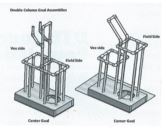
There are two Human Players (HP) on each alliance: one for each corner of the main field. The function of the HPs is to inbound balls to their alliance. The HPs may not score goals themselves. Balls that leave the field of play will be returned to the nearest Human Player.
"Goaltending" is allowed, provided the robot does not have any of its parts attached to, or positioned inside, the goal structure. Robots may not de-score an opponent's ball from a goal. Robots may not "pin" other robots for more than 5 seconds and may not intentionally damage other robots.
Teams partnered with another team to form an "alliance" that competed against an opposing alliance. For each match, the pair of teams in the RED alliance played against the randomly assigned pair of teams in the BLUE alliance. Each match lasted 2 minutes during which time, alliances scored points by putting balls into goal structures. The smaller, yellow balss counted for one point when placed inside one of the alliance's four goals. If a large green bonus ball was placed on top of a goal, the point value of the goal was doubled.
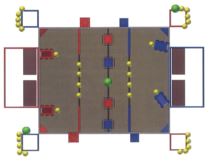
Only robots could score balls into the tall, tower goals. Both robots and "Human Players" could score balls into the smaller, mobile goals. Robots could attempt to block or push opposing robots, but "goaltending" was not allowed. Balls that unintentionally went out of bounds were returned by OCCRA officials to the nearest Human Player to where the ball went out.
Robots could not HOLD more than 3 balls at a time. Robots could push opponents' robots and goals but not grab, hold or attach to them. Robots could only attach to one goal at a time and it could only be one of their own ALLIANCE's goals. Pinninga robot for more than three (3) seconds and preventing them from moving was not allowed.

If any part of an opponent's mobile goal was on or above an alliance's ENDZONE at the end of a match, the alliance received a 2 point bonus. The score for each alliance calculated by adding the alliance's goal points at the end of the match, plus any bonus point, minus any penalty points that were assessed. The alliance with the highest amount of points was the winner. The winners of the match each received 10 bonus points plus their match score. The losing teams received only their patch points.
Each match pitted two alliances, the red alliance and the blue alliance, against each other. The two-team alliance that had the most points at the end of a match was declared the winner and advanced in the tournament. Robots scored in three different ways: one pint was scored for each ball that was placed into the alliance's GRID GOAL (the 5 by 5 grid structure painted their color.) If an alliance had managed to fill all of the GRID GOAL's cells with balls, they would have earned an additional 3-point bonus for this "GRIDLOCK!" (But it never happened!) Robots also scored 3 points for each ball shot into their alliance's BONUS GOAL (through the square opening in the backboard above their opponent's GRID GOAL.) Finally, robots that were hanging at the end of the match (completely off the carpet and supported by the HANGING BAR) earned a 3-point bonus.
Each match pitted two alliances, the red alliance and the blue alliance, against each other. The two-team alliance that had the most points at the end of a match was 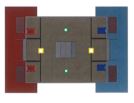
The game this year, "8-BALL," was played in the classic OCCRA two-on-two format. 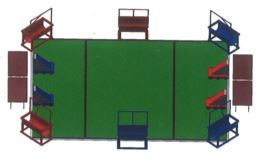
Six GAMEBALLS were "racked up" in the center of the field to start each match, and the other 26 GAMEBALLS were input by robots working with human players. The objective of each two-team alliance was to score as many balls as possible in the goals in two minutes, while preventing opponents from doing the same. During the last 30 seconds of the match, the large, 24" white CUEBALL and black 8-BALL were launched onto the field. While both scored two points for the alliances whose robots possessed them at the end of the match, the big pay-off went to teams that put them into the goals. The 8-BALL scored five points for the scoring team but the CUEBALL negated the entire score of the pocket-goal where it was scored. Clever strategy and "thinking on the fly" became essential for success.
Students were given six weeks to design and build 120-pound robots that could score 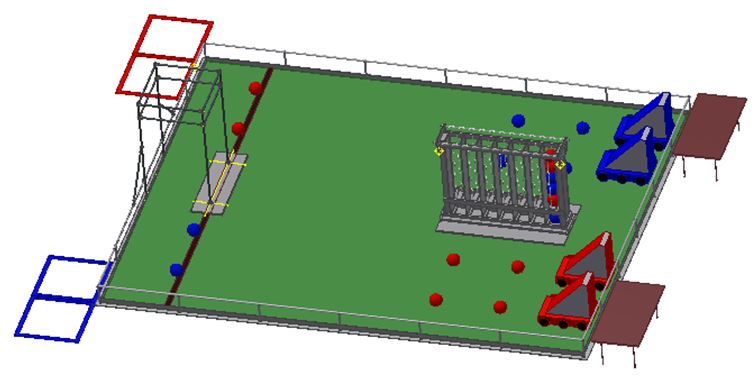
2018 - Over n' Out
2019 - Roll the Dice